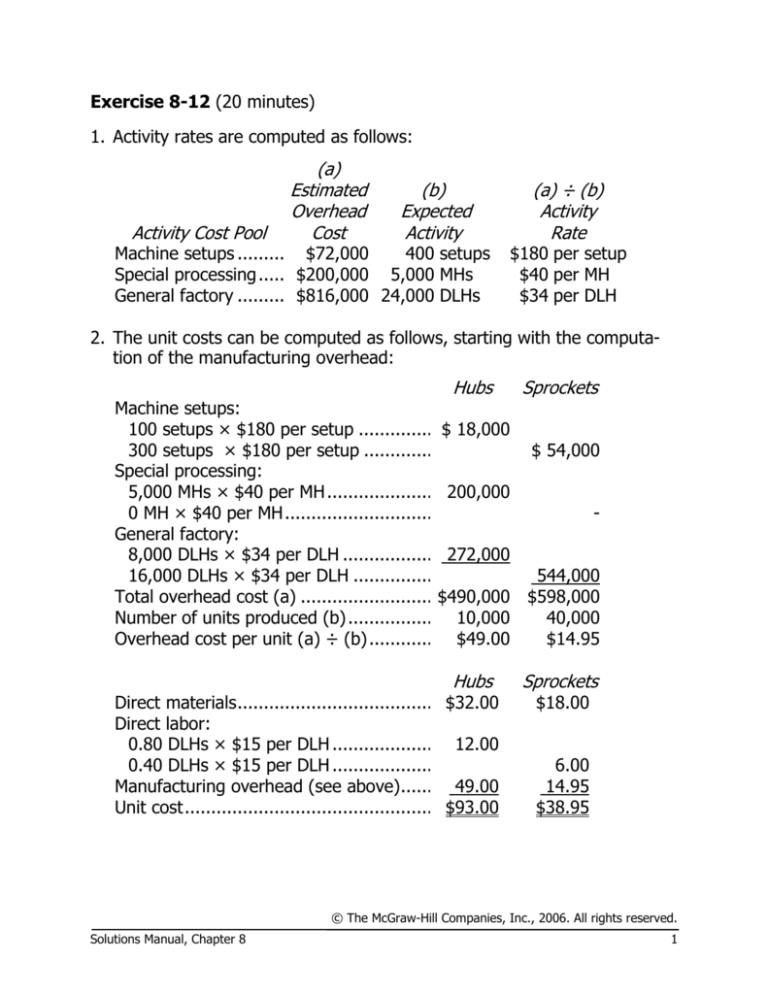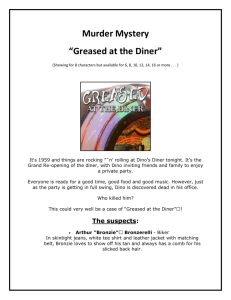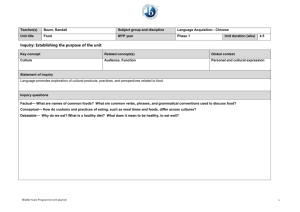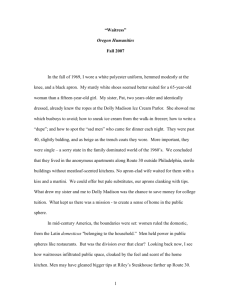
Exercise 8-12 (20 minutes)
1. Activity rates are computed as follows:
Activity Cost Pool
(a)
Estimated
Overhead
Cost
(b)
Expected
Activity
(a) ÷ (b)
Activity
Rate
Machine setups ..............................................................
$72,000
400 setups $180 per setup
Special processing ..........................................................
$200,000 5,000 MHs
$40 per MH
General factory ..............................................................
$816,000 24,000 DLHs
$34 per DLH
2. The unit costs can be computed as follows, starting with the computation of the manufacturing overhead:
Hubs
Sprockets
Hubs
Sprockets
Machine setups:
100 setups × $180 per setup .......................................
$ 18,000
300 setups × $180 per setup ......................................
$ 54,000
Special processing:
5,000 MHs × $40 per MH .............................................
200,000
0 MH × $40 per MH .....................................................
General factory:
8,000 DLHs × $34 per DLH ..........................................
272,000
16,000 DLHs × $34 per DLH ........................................
544,000
Total overhead cost (a) ..................................................
$490,000 $598,000
Number of units produced (b) .........................................
10,000
40,000
Overhead cost per unit (a) ÷ (b) .....................................
$49.00
$14.95
Direct materials ..............................................................
$32.00
$18.00
Direct labor:
0.80 DLHs × $15 per DLH ............................................
12.00
0.40 DLHs × $15 per DLH ............................................6.00
Manufacturing overhead (see above)...............................
49.00
14.95
Unit cost ........................................................................
$93.00
$38.95
© The McGraw-Hill Companies, Inc., 2006. All rights reserved.
Solutions Manual, Chapter 8
1
Exercise 8-13 (30 minutes)
1. The first step is to determine the activity rates:
(a)
Activity Cost Pools Total Cost
(b)
Total Activity
(a) ÷ (b)
Activity Rate
Serving parties ...............................................................
$33,000 6,000 parties
$5.50 per party
Serving diners ................................................................
$138,000 15,000 diners
$9.20 per diner
Serving drinks ................................................................
$24,000 10,000 drinks
$2.40 per drink
According to the activity-based costing system, the cost of serving each
of the parties can be computed as follows:
a. Party of 4 persons who order a total of 3 drinks:
Activity Cost Pool
(a)
Activity Rate
(b)
Activity
(a) × (b)
ABC Cost
(b)
Activity
(a) × (b)
ABC Cost
(b)
Activity
(a) × (b)
ABC Cost
Serving parties ...............................................................
$5.50 per party
1 party
$ 5.50
Serving diners ................................................................
$9.20 per diner
4 diners
36.80
Serving drinks ................................................................
$2.40 per drink
3 drinks
7.20
Total .............................................................................
$49.50
b. Party of 2 persons who order no drinks:
Activity Cost Pool
(a)
Activity Rate
Serving parties ...............................................................
$5.50 per party
1 party
$ 5.50
Serving diners ................................................................
$9.20 per diner
2 diners
18.40
Serving drinks ................................................................
$2.40 per drink
0 drinks
0
Total .............................................................................
$23.90
c. Party of 1 person who orders 2 drinks:
Activity Cost Pool
(a)
Activity Rate
Serving parties ...............................................................
$5.50 per party
1 party
$ 5.50
Serving diners ................................................................
$9.20 per diner
1 diner
9.20
Serving drinks ................................................................
$2.40 per drink
2 drinks
4.80
Total .............................................................................
$19.50
© The McGraw-Hill Companies, Inc., 2006. All rights reserved.
2
Managerial Accounting, 111thEdition
Exercise 8-13 (continued)
2. The average cost per diner for each party can be computed by dividing
the total cost of the party by the number of diners in the party as follows:
a. $49.50 ÷ 4 diners = $12.375 per diner
b. $23.90 ÷ 2 diners = $11.95 per diner
c. $19.50 ÷ 1 diner = $19.50 per diner
3. The average cost per diner differs from party to party under the activitybased costing system for two reasons. First, the cost of serving a party
($5.50) does not depend on the number of diners in the party. Therefore, the average cost per diner of this activity decreases as the number
of diners in the party increases. With only one diner, the cost is $5.50.
With two diners, the average cost per diner is cut in half to $2.75. With
five diners, the average cost per diner would be only $1.10. And so on.
Second, the average cost per diner differs also because of the differences in the number of drinks ordered by the diners. If a party does not
order any drinks, as was the case with the party of two, no costs of
serving drinks are assigned to the party.
The average cost per diner differs from the overall average cost of $16
per diner for several reasons. First, the average cost of $16 per diner includes organization-sustaining costs that are excluded from the computations in the activity-based costing system. Second, the $16 per diner
figure does not recognize differences in the diners’ demands on resources. It does not recognize that some diners order more drinks than
others nor does it recognize the economies of scale in serving larger
parties. (The batch-level costs of serving a party can be spread over
more diners if the party is larger.)
We should note that the activity-based costing system itself does not
recognize all of the differences in diners’ demands on resources. For example, there are undoubtedly differences in the costs of preparing the
various meals on the menu. It may or may not be worth the effort to
build a more detailed activity-based costing system that would take such
nuances into account.
© The McGraw-Hill Companies, Inc., 2006. All rights reserved.
Solutions Manual, Chapter 8
3
Exercise 8-19 (45 minutes)
1. The unit product costs under the company's conventional costing system
would be computed as follows:
Number of units produced (a) .....................
Direct labor-hours per unit (b) .....................
Total direct labor-hours (a) × (b) ................
Total manufacturing overhead (a) ...............
Total direct labor-hours (b) .........................
Predetermined overhead rate (a) ÷ (b) ........
Direct materials ..........................................
Direct labor ................................................
Manufacturing overhead applied:
0.40 DLH per unit × $24.00 per DLH .........
0.20 DLH per unit × $24.00 per DLH .........
Unit product cost ........................................
Rascon
20,000
0.40
8,000
Parcel
80,000
0.20
16,000
Total
24,000
$576,000
24,000 DLHs
$ 24.00 per DLH
Rascon
$13.00
6.00
9.60
$28.60
Parcel
$22.00
3.00
4.80
$29.80
© The McGraw-Hill Companies, Inc., 2006. All rights reserved.
4
Managerial Accounting, 11th Edition
Exercise 8-19 (continued)
2. The unit product costs with the proposed ABC system can be computed as follows:
Activity Cost Pool
Labor related ...........
Engineering design ...
Estimated
Overhead
Cost*
$288,000
$288,000
(b)
Expected Activity
(a) ÷ (b)
Activity Rate
24,000 direct labor-hours $12.00 per direct labor-hour
6,000 engineering-hours $48.00 per engineering-hour
*The total overhead cost is split evenly between the two activity cost pools.
Rascon
Expected
Activity
Amount
Labor related at $12.00 per direct labor-hour ...................
Engineering design at $48.00 per engineering-hour ..........
Total overhead cost assigned (a).....................................
Number of units produced (b) .........................................
Overhead cost per unit (a) ÷ (b ......................................
8,000
3,000
$ 96,000
144,000
$240,000
20,000
$12.00
Parcel
Expected
Activity
Amount
16,000 $192,000
3,000
144,000
$336,000
80,000
$4.20
The unit product costs combine direct materials, direct labor, and overhead costs:
Rascon
Parcel
Direct materials ..............................................................
$13.00 $22.00
Direct labor ....................................................................
6.00
3.00
Manufacturing overhead (see above) ...............................
12.00
4.20
Unit product cost ............................................................
$31.00 $29.20
© The McGraw-Hill Companies, Inc., 2006. All rights reserved.
Solutions Manual, Chapter 8
5
Exercise 8-19 (continued)
3. The unit product cost of the high-volume product, Parcel, declines under the activity-based costing
system, whereas the unit product cost of the low-volume product, Rascon, increases. This occurs because half of the overhead is applied on the basis of engineering design hours instead of direct laborhours. When the overhead was applied on the basis of direct labor-hours, most of the overhead was
applied to the high-volume product. However, when the overhead is applied on the basis of engineering-hours, more of the overhead cost is shifted over to the low-volume product. Engineering-hours is
a product-level activity, so the higher the volume, the lower the unit cost and the lower the volume,
the higher the unit cost.
© The McGraw-Hill Companies, Inc., 2006. All rights reserved.
6
Managerial Accounting, 10th Edition







